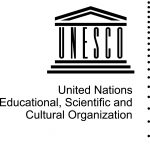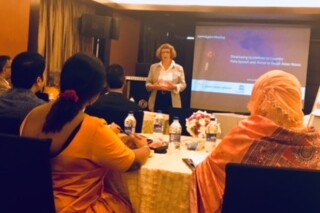We are pleased to announce our latest project to strengthen the capacity of South Asian news media to report on terrorism, violence and hate speech.
Building on the success of our project to develop social media guidelines for journalists in the Caribbean, we will be holding a one day consultation in Chennai, India, to develop a collaborative set of guidelines on all aspects of terrorism coverage such as language, significance and context as well as accuracy and balance.
With the proliferation of news media through digitalisation and growing access to multimedia content, news organisations have more responsibility than ever to produce timely and accurate content on behalf of a diverse public. This is particularly the case in South Asia, where the 2016 Global Terrorism Index (GTI) ranked India and Pakistan among those countries with the highest incidence of terrorism events.
Collaboration is essential and with a specific focus on Bangladesh, India, Nepal, Pakistan and Sri Lanka, we are inviting senior media professionals from across the region to attend the consultation and contribute their experience to the development of the guidelines.
The consultation will take place on the 21 October 2017, with participants also able to attend the Organisation of News Ombudsmen (ONO) conference, which takes place in Chennai from the 22-25 October. This year’s conference theme is “Freedom & Accountability in today’s News: Free & fair is not fake”.
The consultation and guidelines will be implemented by the Public Media Alliance and UNESCO IPDC, with support from the News Broadcast Association of India and the ONO.
For more information about attendance email info@publicmediaalliance.org for details.
Terrorism is brutal and violent. But it is also a media phenomenon, exacerbated by the digital media age.
News of terrorist incidents is vital: an important story of significant public interest. But terrorism also relies on this publicity to disrupt society, provoke fear and demonstrate power.
Terrorism is not a new phenomenon in South Asia, its prevalence is reflected in the Global Terrorism Index (GTI) 2016, which ranked two countries from the region among those with the highest incidence of terrorism—Pakistan and India.
The region’s history has been shaped by political violence, sectarian tensions and postcolonial experiences that continue to inform the process of nation and state-building and shape the expectations (and disappointments) of citizens about the roles and functions of their governments. In South East Asia bombings and explosives account for 51 percent of attacks while firearms account for 32 per cent.
Journalists and the press have historically played a dual role of both amplifying and interrogating campaign messages and political statements in relation to terror and defence. However, this relationship is now further complicated by the use of social media platforms as tools to both report and source stories from.
As media technology continues to evolve, becoming an increasingly dominant actor in politics, the growing power of the media is accompanied by increased responsibility for news organisations. Journalism that reports, analyses and comments upon terror faces a challenge in creating narratives that are accurate, intelligible and socially responsible. Many of the issues journalists face also relate to wider journalism practices, especially around breaking news and conflict journalism. Arguably reporting terrorist attacks can fulfil the aims of terrorism itself in spreading fear but stifling or limiting coverage can fuel both distrust in the news media and undemocratic practices such as censorship.
In recent years this problem has become more acute and more complicated technically, practically and ethically with the acceleration of the news cycle and the advent of social media. In a globalised world, media travels as fast as the speed of light and journalists must understand the full implications of their work. News events are amplified by social media, which often host the “first draft” of terror coverage. These platforms are specifically targeted by terrorists and yet also referenced by journalists. The globalised social media giants, platforms such as Google, Twitter and Facebook often have only a short history of dealing with the political and commercial pressures while many newsrooms have covered terrorism for decades. The fear is that the reporting of terror is becoming too sensationalist and simplistic in the digitally driven rush and that the role of professional journalism has been constrained and diminished.
In the competitive world of media, the rush is frequently to be first, not best. Individual journalists come under great pressure and there is little time for checking facts and images or corroborating information and virtually no space for relaxed discussions to agree ethics. Even the best journalists can sometimes, inadvertently, do damage when they report controversial stories out of context.
Knowing what to report on terrorism is difficult because while many people want to know the facts of a situation immediately, there are certain details which should be withheld to protect those still in crisis and for legitimate legal reasons to ensure that evidence is protected for investigations and prosecutions.
A failure of principle in the newsroom and poor understanding of the potential impact of words and images can lead to acts of journalism that encourage hatred, terrorism and violence. The multifaceted, fast paced nature of today’s media landscape in South Asia and its proliferation mean that news organisations need to be more vigilant than ever in ensuring that they report in an accurate, informed and timely manner.
To strengthen the capacity of media in India, Bangladesh, Pakistan, Nepal & Sri Lanka region by adopting clear guidelines on reporting terrorism, violence and hate speech. UNESCO’s Media & Terrorism Handbook will form the foundation for the guidelines.
Working collaboratively with news organisations across the region to develop detailed guidelines on all aspects of terrorism coverage, that deal with language, significance, and context, as well as accuracy and balance.
Expected outcomes
· Strengthening the role of the media in addressing violence and terrorism in South Asia.
· Developing Guidelines on reporting all aspects of terrorism coverage which will be followed up with a workshop in 2018.
· News media organisations implement detailed guidelines on all aspects of terrorism coverage.
· An internal process that allows broadcasters to reflect, discuss problems and best practices, and improve.
· Internal reviews and assessments put in place to make sure best practices are maintained even in breaking news or developing story situations.
· Ensure that broadcasters are as transparent as possible with the audience about their sources and the limits of their knowledge.
· Media transparency.
· Clear verification & accuracy guidelines for Social media stories.
In partnership with:

Related Posts
23rd October 2017
